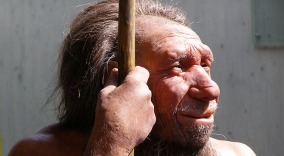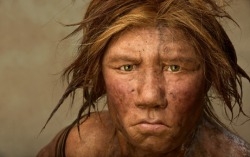the evolution of facial expressions
What sorts of evolutionary pressures could have existed that would explain why we now express ourselves with our faces?
Scientists have yet to come up with a convincing argument that would suggest that displaying one's emotions to each other would have been evolutionarily advantageous enough for our ancestors to have been selected for survival or reproduction on account of their ability to make facial expressions. Even Darwin, the father of the idea of natural selection, wrote in his The Expression of the Emotions in Man and Animals that "there are no grounds, as far as I can discover, for believing that any muscle has been developed or even modified exclusively for the sake of expression" (354 qtd in Russell). However, this does not mean that evolution did not have any influence in bringing about the existence of facial expressions as a characteristic feature of the human race.
Similar to Darwin and his way of thinking, professor of psychology George Mandler also notes that it is fairly unlikely that we evolved facial expressions so that we could communicate our feelings to one another. He believes that facial expressions are "leftovers of a proverbial gestural language". In his opinion, they are remnants of a system of nonverbal communication among early humans (Mandler).
David Matsumoto also finds merit in the idea that facial expression are more of a "leftover" characteristic rather than a direct result of a certain evolutionary pressure. He has been quoted as saying, ""It could be that our emotions, and the systems to regulate them, are vestiges of our evolutionary ancestry. It's possible that in response to negative emotions, humans have developed a system that closes the mouth so that they are prevented from yelling, biting or throwing insults." (Bryner).
So while facial expressions on their own were most likely not a direct result of some sort of evolutionary pressure, they were probably part of a human system of communication that resulted from the evolutionary pressure for people to communicate ideas to each other.
Similar to Darwin and his way of thinking, professor of psychology George Mandler also notes that it is fairly unlikely that we evolved facial expressions so that we could communicate our feelings to one another. He believes that facial expressions are "leftovers of a proverbial gestural language". In his opinion, they are remnants of a system of nonverbal communication among early humans (Mandler).
David Matsumoto also finds merit in the idea that facial expression are more of a "leftover" characteristic rather than a direct result of a certain evolutionary pressure. He has been quoted as saying, ""It could be that our emotions, and the systems to regulate them, are vestiges of our evolutionary ancestry. It's possible that in response to negative emotions, humans have developed a system that closes the mouth so that they are prevented from yelling, biting or throwing insults." (Bryner).
So while facial expressions on their own were most likely not a direct result of some sort of evolutionary pressure, they were probably part of a human system of communication that resulted from the evolutionary pressure for people to communicate ideas to each other.
How does thinking about facial expression from an evolutionary standpoint change the way that we define the purpose of facial expression?
The majority of psychologists and ethologists up through the 1980's assumed that facial expressions were inextricably linked with emotions. However, as more and more research was conducted, scientists realized that there was not a lot of evidence that proved that emotions are a necessary part of facial expression. There has been somewhat of a divide between researchers who have focused on studying facial expression; some people have held an "emotions view" of facial expression while others believe in a "communicative" or "behavioral" view. When facial expression first sparked interest among scientists, most people followed the emotional way of thinking. It seemed logical that facial expressions are expressions of something that is going on inside one's self, something that we call "emotions". However, certain ideas that conflicted with this view gradually became more popular, such as the idea of Darwin that there would probably be very little evolutionary pressure that would be selective for the revelation of one's emotions to another. Researchers began to think of new ways to think of facial expressions that would coincide with their ideas about their evolution.
A common alternative way of thinking of facial expressions is that they are simply communicative. They are signals, expressing a message. The message that they are expressing very well could be an emotional message, but the distinction is that, by this view, facial displays are not necessarily reflective of a specific interior disposition (which some would call an emotion). This view is less constricting and is less easily critiqued because it lacks the very specific designations that characterize the emotions view (Fridlund).
A common alternative way of thinking of facial expressions is that they are simply communicative. They are signals, expressing a message. The message that they are expressing very well could be an emotional message, but the distinction is that, by this view, facial displays are not necessarily reflective of a specific interior disposition (which some would call an emotion). This view is less constricting and is less easily critiqued because it lacks the very specific designations that characterize the emotions view (Fridlund).


